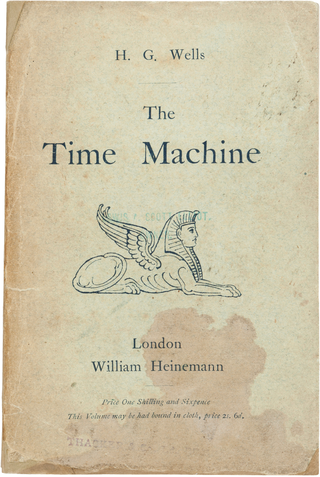Related Research Articles
Faster-than-light travel and communication are the conjectural propagation of matter or information faster than the speed of light. The special theory of relativity implies that only particles with zero rest mass may travel at the speed of light, and that nothing may travel faster.

General relativity, also known as the general theory of relativity and Einstein's theory of gravity, is the geometric theory of gravitation published by Albert Einstein in 1915 and is the current description of gravitation in modern physics. General relativity generalises special relativity and refines Newton's law of universal gravitation, providing a unified description of gravity as a geometric property of space and time or four-dimensional spacetime. In particular, the curvature of spacetime is directly related to the energy and momentum of whatever matter and radiation are present. The relation is specified by the Einstein field equations, a system of second order partial differential equations.

Time travel is the hypothetical activity of traveling into the past or future. Time travel is a widely recognized concept in philosophy and fiction, particularly science fiction. In fiction, time travel is typically achieved through the use of a hypothetical device known as a time machine. The idea of a time machine was popularized by H. G. Wells's 1895 novel The Time Machine.
A wormhole is a hypothetical structure connecting disparate points in spacetime, and is based on a special solution of the Einstein field equations.
The Novikov self-consistency principle, also known as the Novikov self-consistency conjecture and Larry Niven's law of conservation of history, is a principle developed by Russian physicist Igor Dmitriyevich Novikov in the mid-1980s. Novikov intended it to solve the problem of paradoxes in time travel, which is theoretically permitted in certain solutions of general relativity that contain what are known as closed timelike curves. The principle asserts that if an event exists that would cause a paradox or any "change" to the past whatsoever, then the probability of that event is zero. It would thus be impossible to create time paradoxes.

The Alcubierre drive is a speculative warp drive idea according to which a spacecraft could achieve apparent faster-than-light travel by contracting space in front of it and expanding space behind it, under the assumption that a configurable energy-density field lower than that of vacuum could be created. Proposed by theoretical physicist Miguel Alcubierre in 1994, the Alcubierre drive is based on a solution of Einstein's field equations. Since those solutions are metric tensors, the Alcubierre drive is also referred to as Alcubierre metric.

A gravitational singularity, spacetime singularity or simply singularity is a condition in which gravity is predicted to be so intense that spacetime itself would break down catastrophically. As such, a singularity is by definition no longer part of the regular spacetime and cannot be determined by "where" or "when". Gravitational singularities exist at a junction between general relativity and quantum mechanics; therefore, the properties of the singularity cannot be described without an established theory of quantum gravity. Trying to find a complete and precise definition of singularities in the theory of general relativity, the current best theory of gravity, remains a difficult problem. A singularity in general relativity can be defined by the scalar invariant curvature becoming infinite or, better, by a geodesic being incomplete.

Kip Stephen Thorne is an American theoretical physicist known for his contributions in gravitational physics and astrophysics. Along with Rainer Weiss and Barry C. Barish, he was awarded the 2017 Nobel Prize in Physics for his contributions to the LIGO detector and the observation of gravitational waves.
In mathematical physics, a closed timelike curve (CTC) is a world line in a Lorentzian manifold, of a material particle in spacetime, that is "closed", returning to its starting point. This possibility was first discovered by Willem Jacob van Stockum in 1937 and later confirmed by Kurt Gödel in 1949, who discovered a solution to the equations of general relativity (GR) allowing CTCs known as the Gödel metric; and since then other GR solutions containing CTCs have been found, such as the Tipler cylinder and traversable wormholes. If CTCs exist, their existence would seem to imply at least the theoretical possibility of time travel backwards in time, raising the spectre of the grandfather paradox, although the Novikov self-consistency principle seems to show that such paradoxes could be avoided. Some physicists speculate that the CTCs which appear in certain GR solutions might be ruled out by a future theory of quantum gravity which would replace GR, an idea which Stephen Hawking labeled the chronology protection conjecture. Others note that if every closed timelike curve in a given spacetime passes through an event horizon, a property which can be called chronological censorship, then that spacetime with event horizons excised would still be causally well behaved and an observer might not be able to detect the causal violation.
The Penrose–Hawking singularity theorems are a set of results in general relativity that attempt to answer the question of when gravitation produces singularities. The Penrose singularity theorem is a theorem in semi-Riemannian geometry and its general relativistic interpretation predicts a gravitational singularity in black hole formation. The Hawking singularity theorem is based on the Penrose theorem and it is interpreted as a gravitational singularity in the Big Bang situation. Penrose was awarded the Nobel Prize in Physics in 2020 "for the discovery that black hole formation is a robust prediction of the general theory of relativity", which he shared with Reinhard Genzel and Andrea Ghez.
A Tipler cylinder, also called a Tipler time machine, is a hypothetical object theorized to be a potential mode of time travel—although results have shown that a Tipler cylinder could only allow time travel if its length were infinite or with the existence of negative energy.
Micro black holes, also called mini black holes or quantum mechanical black holes, are hypothetical tiny black holes, for which quantum mechanical effects play an important role. The concept that black holes may exist that are smaller than stellar mass was introduced in 1971 by Stephen Hawking.

The black hole information paradox is a paradox that appears when the predictions of quantum mechanics and general relativity are combined. The theory of general relativity predicts the existence of black holes that are regions of spacetime from which nothing—not even light—can escape. In the 1970s, Stephen Hawking applied the semiclassical approach of quantum field theory in curved spacetime to such systems and found that an isolated black hole would emit a form of radiation called Hawking radiation. He also argued that the detailed form of the radiation would be independent of the initial state of the black hole, and depend only on its mass, electric charge and angular momentum.
A temporal paradox, time paradox, or time travel paradox, is a paradox, an apparent contradiction, or logical contradiction associated with the idea of time travel or other foreknowledge of the future. While the notion of time travel to the future complies with the current understanding of physics via relativistic time dilation, temporal paradoxes arise from circumstances involving hypothetical time travel to the past – and are often used to demonstrate its impossibility.
In general relativity, a Roman ring is a configuration of wormholes where no subset of wormholes is near to chronology violation, though the combined system can be arbitrarily close to chronology violation.

In theoretical physics, quantum field theory in curved spacetime (QFTCS) is an extension of quantum field theory from Minkowski spacetime to a general curved spacetime. This theory uses a semi-classical approach; it treats spacetime as a fixed, classical background, while giving a quantum-mechanical description of the matter and energy propagating through that spacetime. A general prediction of this theory is that particles can be created by time-dependent gravitational fields (multigraviton pair production), or by time-independent gravitational fields that contain horizons. The most famous example of the latter is the phenomenon of Hawking radiation emitted by black holes.
A Krasnikov tube is a speculative mechanism for space travel involving the warping of spacetime into permanent superluminal tunnels. The resulting structure is analogous to a wormhole or an immobile Alcubierre drive with the endpoints displaced in time as well as space. The idea was proposed by Sergey Krasnikov in 1995.

Quantum cosmology is the attempt in theoretical physics to develop a quantum theory of the universe. This approach attempts to answer open questions of classical physical cosmology, particularly those related to the first phases of the universe.

Ronald Lawrence Mallett is an American theoretical physicist, academic and author. He has been a faculty member of the University of Connecticut since 1975 and is best known for his position on the possibility of time travel.
Misner space is an abstract mathematical spacetime, first described by Charles W. Misner. It is also known as the Lorentzian orbifold . It is a simplified, two-dimensional version of the Taub–NUT spacetime. It contains a non-curvature singularity and is an important counterexample to various hypotheses in general relativity.
References
- Hawking, S.W., (1992) The chronology protection conjecture. Phys. Rev. D46, 603–611.
- Matt Visser, "The quantum physics of chronology protection" in The Future of Theoretical Physics and Cosmology: Celebrating Stephen Hawking's 60th Birthday by G. W. Gibbons (Editor), E. P. S. Shellard (Editor), S. J. Rankin (Editor)
- Li, Li-Xin (1996). "Must Time Machine Be Unstable against Vacuum Fluctuations?". Class. Quantum Grav. 13 (9): 2563–2568. arXiv: gr-qc/9703024 . Bibcode:1996CQGra..13.2563L. doi:10.1088/0264-9381/13/9/019. S2CID 250909592.